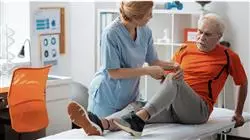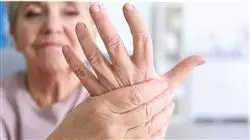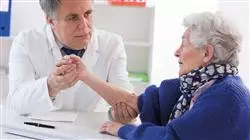
Certificate
The world's largest faculty of physiotherapy”
Description
A complete study about the most outstanding advances in the attention and care of patients with pain from the techniques of physiotherapy work in the geriatric area"

One of the priorities of physiotherapists is to achieve pain management that allows sufferers to find the wellbeing they need. This applies to all types of patients, but especially geriatric patients who require greater delicacy in all interventions.
To this end, the professional must assess and explore the patient's resistance and physiological reserves in order to establish the appropriate framework for action and choose between home care, residential care, day care centers, social centers or private clinics.
Treatment should include pre-frailty, frailty, trauma and neurological disorders, respiratory and/or pelvic floor disorders, which may be associated with gerontological syndromes or cognitive impairment, side effects of drugs and/or biopsychosocial conditions that may complicate the clinical picture.
It is therefore essential to know the tools of physiotherapy and the appropriateness of their application in each case, such as active exercise, manual therapy and electrotherapy. Being able to work in an interdisciplinary team, with appropriate communication tools, understanding the concept of person-centered care, having the most up-to-date knowledge of support devices and even the support of current technology can be key to success in physical therapy treatment.
Learn how to treat, prevent or alleviate pain derived from aging and the most common associated disorders"
This postgraduate diploma in Pain and Aging in Physical Therapy offers you the characteristics of a program of high-level scientific, teaching and technological level. These are some of its most notable features:
- The latest technology in online teaching software
- A highly visual teaching system, supported by graphic and schematic contents that are easy to assimilate and understand
- Practical cases presented by practising experts
- State-of-the-art interactive video systems
- Teaching supported by telepractice
- Continuous updating and recycling systems
- Autonomous learning: full compatibility with other occupations
- Practical exercises for self-evaluation and learning verification
- Support groups and educational synergies: questions to the expert, debate and knowledge forums
- Communication with the teacher and individual reflection work
- Content that is accessible from any fixed or portable device with internet connection
- Supplementary documentation databases are permanently available, even after the programa
Boost your professional growth with the convenience of a postgraduate diploma that adapts to your pace and real study possibilities”
The program’s teaching staff includes professionals from the sector who contribute their work experience to this program, as well as renowned specialists from leading societies and prestigious universities.
The multimedia content, developed with the latest educational technology, will provide the professional with situated and contextual learning, i.e., a simulated environment that will provide immersive learning programmed to train in real situations.
This program is designed around Problem-Based Learning, whereby the professional must try to solve the different professional practice situations that arise during the academic year. For this purpose, the student will be assisted by an innovative interactive video system created by renowned and experienced experts.
A dynamic and effective postgraduate diploma that will bring a high-impact change to your professional skills"

Using the most efficient audiovisual systems, this postgraduate diploma will allow you to consolidate what you learn through direct and realistic observation"
Objectives
This postgraduate diploma compiles the most current knowledge on pain and aging in physiotherapy in geriatrics. The objective is to provide students with specialized knowledge by creating a well-structured basis to identify the clinical signs associated with the different needs and developments, providing a broad and contextual view of the activity in this field today.

Complete and fully up-to-date, this postgraduate diploma has been created to convert the knowledge you acquire into real intervention competences”
General Objective
- The overall objective is to develop a critical and reasoned attitude, based on the latest scientific evidence, towards the physiotherapeutic diagnosis in the elderly patient and to be able to apply adequate treatment in order to reduce functional impotence, frailty and deterioration, thereby favoring an improvement of physical and mental health in old age
Specific Objectives
Module 1. Clinical Reasoning in Physiogeriatrics
- Explain active aging from the patient’s point of view
- Define the fields of action of physiotherapy in geriatrics
- Define the role of physiotherapy in palliative care units
- Define the use of new technologies in physiogeriatrics
- Explain what interdisciplinary teams in geriatrics consist of
- Define the composition and functioning of the interdisciplinary team
- Explain the main functions within the interdisciplinary team
- Establish the differential diagnosis. Red & yellow flags
- Describe the major geriatric syndromes
- Explain what red and yellow flags consist of
- Define the most common red flags in clinical practice
- Explain the proper approach to the physical therapy session in geriatrics
- Describe the physiotherapeutic examination and assessment of the geriatric patient
- Define the effects on the neuromusculoskeletal system of certain drugs
Module 2. Person-Centered Care (PCC) from a Physiotherapy Perspective
- Explain the process of transformation from a service model to a PCC model
- Explain the provision of physical therapy services in an PCC model
- Describe the decalogue of person-centered care
Module 3. Pain and Aging, Update According to Current Scientific Evidence
- Explain the anatomy and physiology of pain transmission
- Define the different types of pain
- Describe pain and aging from a biopsychosocial paradigm
- Define the different pain syndromes in geriatrics
- Explain how to perform a proper pain assessment
- Explain the pharmacological treatment of pain in the geriatric patient

Incorporate the benefits of physiotherapy in your work with the confidence of an expert and make your CV one of the most competitive in the field of physiotherapy”
Postgraduate Diploma in Pain and Aging in Physiotherapy
Pain and aging are important topics when discussing physical therapy, as many people experience pain due to their aging bodies and the conditions that can arise with age. In physical therapy, pain and aging are addressed through a variety of techniques and treatments that seek to improve the patient's function and quality of life. Pain and aging are key issues in physical therapy, and physical therapists use a variety of techniques and treatments to address these issues and improve the quality of life for patients.
In terms of pain, physical therapy works on the assessment and treatment of different types of pain, including acute pain and chronic pain. Physical therapists use techniques such as manual therapy, therapeutic exercises, electrotherapy and other modalities to decrease the sensation of pain and improve the patient's mobility and function.
In aging, physical therapists work to prevent or treat conditions associated with aging, such as osteoporosis, osteoarthritis and loss of muscle mass. Physical therapists can also develop exercise programs tailored to the needs of older people to improve their balance, strength and mobility, which helps prevent falls and injuries.
The goal of this online academic program is to prepare students to be effective and compassionate physical therapists in the treatment and management of pain and disability in older patients. Students will learn how to assess and treat pain and disability in the elderly and acquire skills that will enable them to improve the quality of life of their patients. Students will learn about effective treatment techniques for aging patients and how to approach pain in a comprehensive manner.






